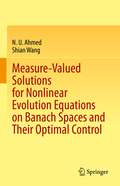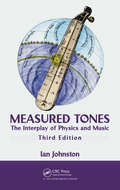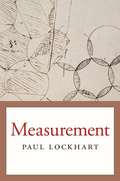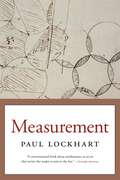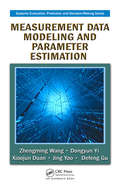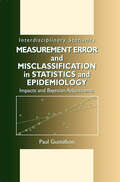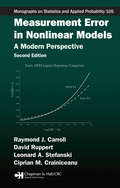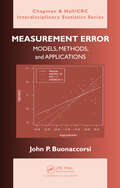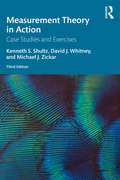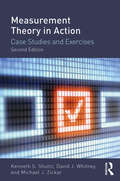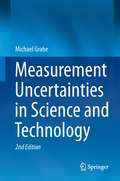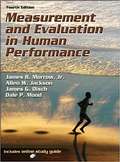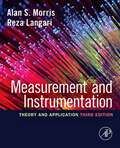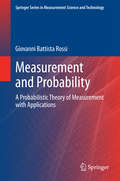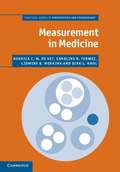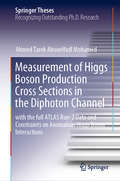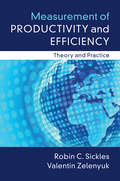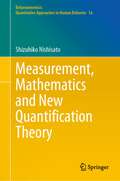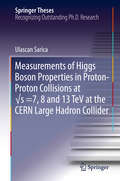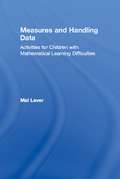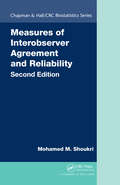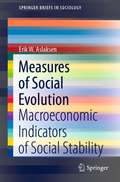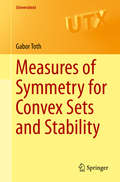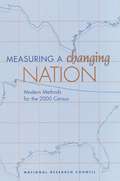- Table View
- List View
Measure-Valued Solutions for Nonlinear Evolution Equations on Banach Spaces and Their Optimal Control
by N. U. Ahmed Shian WangThis book offers the first comprehensive presentation of measure-valued solutions for nonlinear deterministic and stochastic evolution equations on infinite dimensional Banach spaces. Unlike traditional solutions, measure-valued solutions allow for a much broader class of abstract evolution equations to be addressed, providing a broader approach.The book presents extensive results on the existence of measure-valued solutions for differential equations that have no solutions in the usual sense. It covers a range of topics, including evolution equations with continuous/discontinuous vector fields, neutral evolution equations subject to vector measures as impulsive forces, stochastic evolution equations, and optimal control of evolution equations. The optimal control problems considered cover the existence of solutions, necessary conditions of optimality, and more, significantly complementing the existing literature.This book will be of great interest to researchers in functional analysis, partial differential equations, dynamic systems and their optimal control, and their applications, advancing previous research and providing a foundation for further exploration of the field.
Measured Tones: The Interplay of Physics and Music, Third Edition
by Ian JohnstonMost books concerned with physics and music take an approach that puts physical theory before application. Consequently, these works tend to dampen aesthetic fascination with preludes burdened by an overabundance of algebraic formulae. In Measured Tones: The Interplay of Physics and Music Third Edition, Ian Johnston a professor of astrophysics and
Measurement
by Paul LockhartLockhart's Mathematician's Lament outlined how we introduce math to students in the wrong way. Measurement explains how math should be done. With plain English and pictures, he makes complex ideas about shape and motion intuitive and graspable, and offers a solution to math phobia by introducing us to math as an artful way of thinking and living.
Measurement
by Paul LockhartPaul Lockhart’s Mathematician’s Lament outlined how we introduce math to students in the wrong way. Measurement explains how math should be done. With plain English and pictures, Lockhart makes complex ideas about shape and motion intuitive and graspable, and offers a solution to math phobia by introducing us to math as an artful way of thinking and living.In conversational prose that conveys his passion for the subject, Lockhart makes mathematics accessible without oversimplifying. He makes no more attempt to hide the challenge of mathematics than he does to shield us from its beautiful intensity. Favoring plain English and pictures over jargon and formulas, he succeeds in making complex ideas about the mathematics of shape and motion intuitive and graspable. His elegant discussion of mathematical reasoning and themes in classical geometry offers proof of his conviction that mathematics illuminates art as much as science.Lockhart leads us into a universe where beautiful designs and patterns float through our minds and do surprising, miraculous things. As we turn our thoughts to symmetry, circles, cylinders, and cones, we begin to see that almost anyone can “do the math” in a way that brings emotional and aesthetic rewards. Measurement is an invitation to summon curiosity, courage, and creativity in order to experience firsthand the playful excitement of mathematical work.
Measurement Data Modeling and Parameter Estimation (Systems Evaluation, Prediction, and Decision-Making)
by Xiaojun Duan Zhengming Wang Dongyun Yi Jing Yao Defeng GuThis book discusses the theories, methods, and application techniques of the measurement data mathematical modeling and parameter estimation. It seeks to build a bridge between mathematical theory and engineering practice in the measurement data processing field so theoretical researchers and technical engineers can communicate. It is organized with abundant materials, such as illustrations, tables, examples, and exercises. The authors create examples to apply mathematical theory innovatively to measurement and control engineering. Not only does this reference provide theoretical knowledge, it provides information on first hand experiences.
Measurement Error and Misclassification in Statistics and Epidemiology: Impacts and Bayesian Adjustments (Chapman & Hall/CRC Interdisciplinary Statistics)
by Paul GustafsonMismeasurement of explanatory variables is a common hazard when using statistical modeling techniques, and particularly so in fields such as biostatistics and epidemiology where perceived risk factors cannot always be measured accurately. With this perspective and a focus on both continuous and categorical variables, Measurement Error and Misclassification in Statistics and Epidemiology: Impacts and Bayesian Adjustments examines the consequences and Bayesian remedies in those cases where the explanatory variable cannot be measured with precision. The author explores both measurement error in continuous variables and misclassification in discrete variables, and shows how Bayesian methods might be used to allow for mismeasurement. A broad range of topics, from basic research to more complex concepts such as "wrong-model" fitting, make this a useful research work for practitioners, students and researchers in biostatistics and epidemiology."
Measurement Error in Nonlinear Models: A Modern Perspective, Second Edition (Chapman & Hall/CRC Monographs on Statistics and Applied Probability)
by David Ruppert Leonard A. Stefanski Raymond J. Carroll Ciprian M. CrainiceanuIt's been over a decade since the first edition of Measurement Error in Nonlinear Models splashed onto the scene, and research in the field has certainly not cooled in the interim. In fact, quite the opposite has occurred. As a result, Measurement Error in Nonlinear Models: A Modern Perspective, Second Edition has been revamped and ex
Measurement Error: Models, Methods, and Applications (Chapman & Hall/CRC Interdisciplinary Statistics)
by John P. BuonaccorsiOver the last 20 years, comprehensive strategies for treating measurement error in complex models and accounting for the use of extra data to estimate measurement error parameters have emerged. Focusing on both established and novel approaches, Measurement Error: Models, Methods, and Applications provides an overview of the main techniques and illu
Measurement Theory in Action: Case Studies and Exercises
by David J. Whitney Kenneth S Shultz Michael J ZickarMeasurement Theory in Action, Third Edition, helps readers apply testing and measurement theories and features 22 self-contained modules which instructors can match to their courses. Each module features an overview of a measurement issue and a step-by-step application of that theory. Best Practices provide recommendations for ensuring the appropriate application of the theory. Practical Questions help students assess their understanding of the topic. Students can apply the material using real data in the Exercises, some of which require no computer access, while others involve the use of statistical software to solve the problem. Case Studies in each module depict typical dilemmas faced when applying measurement theory followed by Questions to Ponder to encourage critical examination of the issues noted in the cases. The book’s website houses the data sets, additional exercises, PowerPoints, and more. Other features include suggested readings to further one’s understanding of the topics, a glossary, and a comprehensive exercise in Appendix A that incorporates many of the steps in the development of a measure of typical performance. Updated throughout to reflect recent changes in the field, the new edition also features: Recent changes in understanding measurement, with over 50 new and updated references Explanations of why each chapter, article, or book in each module’s Further Readings section is recommended Instructors will find suggested answers to the book’s questions and exercises; detailed solutions to the exercises; test bank with 10 multiple choice and 5 short answer questions for each module; and PowerPoint slides. Students and instructors can access SPSS data sets; additional exercises; the glossary; and additional information helpful in understanding psychometric concepts. It is ideal as a text for any psychometrics or testing and measurement course taught in psychology, education, marketing, and management. It is also an invaluable reference for professional researchers in need of a quick refresher on applying measurement theory.
Measurement Theory in Action: Case Studies and Exercises, Second Edition
by Kenneth S. Shultz Michael J. Zickar David J. WhitneyThis book helps readers apply testing and measurement theories. Featuring 22 self-standing modules, instructors can pick and choose the ones that are most appropriate for their course. Each module features an overview of a measurement issue and a step-by-step application of that theory. Best practices provide recommendations for ensuring the appropriate application of the theory. Practical questions help students assess their understanding of the topic while the examples allow them to apply the material using real data. Two cases in each module depict typical dilemmas faced when applying measurement theory followed by Questions to Ponder to encourage critical examination of the issues noted in the cases. Each module contains exercises some of which require no computer access while others involve the use of SPSS to solve the problem. The book's website houses the accompanying data sets and more. The book also features suggested readings, a glossary of the key terms, and a continuing exercise that incorporates many of the steps in the development of a measure of typical performance. Updated throughout to reflect recent changes in the field, the new edition also features: --A new co-author, Michael Zickar, who updated the advanced topics and added the new module on generalizability theory (Module 22). -Expanded coverage of reliability (Modules 5 & 6) and exploratory and confirmatory factor analysis (Modules 18 & 19) to help readers interpret results presented in journal articles. -Expanded Web Resources, Instructors will now find: suggested answers to the book's questions and exercises; detailed worked solutions to the exercises; and PowerPoint slides. Students and instructors can access the SPSS data sets; additional exercises; the glossary; and website references that are helpful in understanding psychometric concepts. Part 1 provides an introduction to measurement theory and specs for scaling and testing and a review of statistics. Part 2 then progresses through practical issues related to text reliability, validation, meta-analysis and bias. Part 3 reviews practical issues related to text construction such as the development of measures of maximal performance, CTT item analysis, test scoring, developing measures of typical performance, and issues related to response styles and guessing. The book concludes with advanced topics such as multiple regression, exploratory and confirmatory factor analysis, item response theory (IRT), IRT applications including computer adaptive testing and differential item functioning, and generalizability theory. Ideal as a text for any psychometrics, testing and measurement, or multivariate statistics course taught in psychology, education, marketing and management, professional researchers in need of a quick refresher on applying measurement theory will also find this an invaluable reference.
Measurement Uncertainties in Science and Technology
by Michael GrabeThis book recasts the classical Gaussian error calculus from scratch, the inducements concerning both random and unknown systematic errors. The idea of this book is to create a formalism being fit to localize the true values of physical quantities considered - true with respect to the set of predefined physical units. Remarkably enough, the prevailingly practiced forms of error calculus do not feature this property which however proves in every respect, to be physically indispensable. The amended formalism, termed Generalized Gaussian Error Calculus by the author, treats unknown systematic errors as biases and brings random errors to bear via enhanced confidence intervals as laid down by Student. The significantly extended second edition thoroughly restructures and systematizes the text as a whole and illustrates the formalism by numerous numerical examples. They demonstrate the basic principles of how to understand uncertainties to localize the true values of measured values - a perspective decisive in view of the contested physical explorations.
Measurement Uncertainty and Probability
by Robin WillinkA measurement result is incomplete without a statement of its 'uncertainty' or 'margin of error'. But what does this statement actually tell us? By examining the practical meaning of probability, this book discusses what is meant by a '95 percent interval of measurement uncertainty', and how such an interval can be calculated. The book argues that the concept of an unknown 'target value' is essential if probability is to be used as a tool for evaluating measurement uncertainty. It uses statistical concepts, such as a conditional confidence interval, to present 'extended' classical methods for evaluating measurement uncertainty. The use of the Monte Carlo principle for the simulation of experiments is described. Useful for researchers and graduate students, the book also discusses other philosophies relating to the evaluation of measurement uncertainty. It employs clear notation and language to avoid the confusion that exists in this controversial field of science.
Measurement and Evaluation in Human Performance
by Jr. Dale P. Mood James R. Morrow Allen W. Jackson James G. DischMeasurement and Evaluation in Human Performance, Fourth Edition, paves the way for students and professionals to identify and solve human performance problems in the areas of kinesiology, physical education, health, and fitness. Focusing on the concepts of reliability, objectivity, and validity, the text introduces students to tests and measurements and guides them through statistical decision making and accurate interpretation of data. Measurement and Evaluation in Human Performance, Fourth Edition, is designed with student learning in mind with its practical approach, easy-to-read style, and minimal mathematics. Like previous editions, the text combines introductory algebraic concepts with explanations of reliability and validity to assist students in developing the knowledge and tools to gather and analyze data for decision making. The fourth edition also features many upgrades: • An updated online study guide that incorporates more student activities, computer tasks, and quiz questions to help students comprehend the concepts • A realignment of chapters into four cohesive sections leading from background knowledge and basic statistical concepts to supportive theories and practical application • Greater use of Microsoft Excel to assist with statistical calculations, including an appendix of directions, screen captures, and templates for complex calculations • Inclusion of large sample data sets with each chapter’s online study guide content that help students review concepts and emphasize the value of computer skills in the field of measurement and evaluation • More information on physical activity assessment incorporated into all chapters • A new contributor who lends expertise to teachers and coaches in a chapter addressing performance-based assessment In addition to incorporating use of MS Excel, this edition continues to use Predictive Analysis Software (PASW), previously known as Statistical Package for the Social Sciences (SPSS). These computer applications provide students with the skills to quickly complete time-consuming and difficult calculations for large amounts of data.
Measurement and Probability
by Giovanni Battista RossiMeasurement plays a fundamental role both in physical and behavioral sciences, as well as in engineering and technology: it is the link between abstract models and empirical reality and is a privileged method of gathering information from the real world. Is it possible to develop a single theory of measurement for the various domains of science and technology in which measurement is involved? This book takes the challenge by addressing the following main issues: What is the meaning of measurement? How do we measure? What can be measured? A theoretical framework that could truly be shared by scientists in different fields, ranging from physics and engineering to psychology is developed. The future in fact will require greater collaboration between science and technology and between different sciences. Measurement, which played a key role in the birth of modern science, can act as an essential interdisciplinary tool and language for this new scenario. A sound theoretical basis for addressing key problems in measurement is provided. These include perceptual measurement, the evaluation of uncertainty, the evaluation of inter-comparisons, the analysis of risks in decision-making and the characterization of dynamical measurement. Currently, increasing attention is paid to these issues due to their scientific, technical, economic and social impact. The book proposes a unified probabilistic approach to them which may allow more rational and effective solutions to be reached. Great care was taken to make the text as accessible as possible in several ways. Firstly, by giving preference to as interdisciplinary a terminology as possible; secondly, by carefully defining and discussing all key terms. This ensures that a wide readership, including people from different mathematical backgrounds and different understandings of measurement can all benefit from this work. Concerning mathematics, all the main results are preceded by intuitive discussions and illustrated by simple examples. Moreover, precise proofs are always included in order to enable the more demanding readers to make conscious and creative use of these ideas, and also to develop new ones. The book demonstrates that measurement, which is commonly understood to be a merely experimental matter, poses theoretical questions which are no less challenging than those arising in other, apparently more theoretical, disciplines.
Measurement in Medicine
by Dirk L. Knol Henrica C. de Vet Caroline B. Terwee Lidwine B. MokkinkThe success of the Apgar score demonstrates the astounding power of an appropriate clinical instrument. This down-to-earth book provides practical advice, underpinned by theoretical principles, on developing and evaluating measurement instruments in all fields of medicine. It equips you to choose the most appropriate instrument for specific purposes. The book covers measurement theories, methods and criteria for evaluating and selecting instruments. It provides methods to assess measurement properties, such as reliability, validity and responsiveness, and interpret the results. Worked examples and end-of-chapter assignments use real data and well-known instruments to build your skills at implementation and interpretation through hands-on analysis of real-life cases. All data and solutions are available online. This is a perfect course book for students and a perfect companion for professionals/researchers in the medical and health sciences who care about the quality and meaning of the measurements they perform.
Measurement of Higgs Boson Production Cross Sections in the Diphoton Channel: with the full ATLAS Run-2 Data and Constraints on Anomalous Higgs Boson Interactions (Springer Theses)
by Ahmed Tarek Abouelfadl MohamedThis thesis presents the measurement of the Higgs boson cross section in the diphoton decay channel. The measurement relies on proton-proton collision data at a center-of-mass energy √s = 13 TeV recorded by the ATLAS experiment at the Large Hadron Collider (LHC). The collected data correspond to the full Run-2 dataset with an integrated luminosity of 139 fb-1. The measured cross sections are used to constrain anomalous Higgs boson interactions in the Effective Field Theory (EFT) framework. The results presented in this thesis represent a reduction by a factor 2 of the different photon and jet energy scale and resolution systematic uncertainties with respect to the previous ATLAS publication. The thesis details the calibration of electron and photon energies in ATLAS, in particular the measurement of the presampler energy scale and the estimation of its systematic uncertainty. This calibration was used to perform a measurement of the Higgs boson mass in the H → γγ and H → 4l channels using the 36 fb−1 dataset.
Measurement of Productivity and Efficiency: Theory and Practice
by Professor Robin C. Sickles Professor Valentin ZelenyukMethods and perspectives to model and measure productivity and efficiency have made a number of important advances in the last decade. Using the standard and innovative formulations of the theory and practice of efficiency and productivity measurement, Robin C. Sickles and Valentin Zelenyuk provide a comprehensive approach to productivity and efficiency analysis, covering its theoretical underpinnings and its empirical implementation, paying particular attention to the implications of neoclassical economic theory. A distinct feature of the book is that it presents a wide array of theoretical and empirical methods utilized by researchers and practitioners who study productivity issues. An accompanying website includes methods, programming codes that can be used with widely available software like Matlab, R, and Julia, and test data for many of the productivity and efficiency estimators discussed in the book. It will be valuable to upper-level undergraduates, graduate students, and professionals.
Measurement, Mathematics and New Quantification Theory (Behaviormetrics: Quantitative Approaches to Human Behavior #16)
by Shizuhiko NishisatoThe purpose of this book is to thoroughly prepare diverse areas of researchers in quantification theory. As is well known, quantification theory has attracted the attention of a countless number of researchers, some mathematically oriented and others not, but all of them are experts in their own disciplines. Quantifying non-quantitative (qualitative) data requires a variety of mathematical and statistical strategies, some of which are quite complicated. Unlike many books on quantification theory, the current book places more emphasis on preliminary requisites of mathematical tools than on details of quantification theory. As such, the book is primarily intended for readers whose specialty is outside mathematical sciences. The book was designed to offer non-mathematicians a variety of mathematical tools used in quantification theory in simple terms. Once all the preliminaries are fully discussed, quantification theory is then introduced in the last section as a simple application of those mathematical procedures fully discussed so far. The book opens up further frontiers of quantification theory as simple applications of basic mathematics.
Measurements of Higgs Boson Properties in Proton-Proton Collisions at √s =7, 8 and 13 TeV at the CERN Large Hadron Collider (Springer Theses)
by Ulascan SaricaThis thesis documents the measurement of lifetime, width, mass, and couplings to two electroweak bosons of the recently-discovered Higgs boson using data from the CMS experiment at the Large Hadron Collider. Both on-shell (at the mass of around 125 GeV) and off-shell (above 200 GeV) Higgs boson production is studied and an excess of off-shell production with significance above two standard deviations is observed for the first time. The latter is a qualitative new way to study the Higgs field, responsible for generation of mass of all the known elementary particles. In addition, phenomenological tools have been developed with the Monte Carlo event generator and matrix element techniques for an optional analysis of LHC data. Optimization of the CMS data with careful alignment of the silicon tracker is also presented.
Measures and Handling Data: Activities for Children with Mathematical Learning Difficulties
by Mel LeverFirst Published in 2003. Routledge is an imprint of Taylor & Francis, an informa company.
Measures of Interobserver Agreement and Reliability (Chapman & Hall/CRC Biostatistics Series)
by Mohamed M. ShoukriMeasures of Interobserver Agreement and Reliability, Second Edition covers important issues related to the design and analysis of reliability and agreement studies. It examines factors affecting the degree of measurement errors in reliability generalization studies and characteristics influencing the process of diagnosing each subject in a reliability study. The book also illustrates the importance of blinding and random selection of subjects.New to the Second Edition New chapter that describes various models for methods comparison studies New chapter on the analysis of reproducibility using the within-subjects coefficient of variation Emphasis on the definition of the subjects’ and raters’ population as well as sample size determination This edition continues to offer guidance on how to run sound reliability and agreement studies in clinical settings and other types of investigations. The author explores two ways of producing one pooled estimate of agreement from several centers: a fixed-effect approach and a random sample of centers using a simple meta-analytic approach. The text includes end-of-chapter exercises as well as downloadable resources of data sets and SAS code.
Measures of Social Evolution: Macroeconomic Indicators of Social Stability (SpringerBriefs in Sociology)
by Erik W. AslaksenThis book extends a previously published model of social evolution by using macroeconomic measures to indicate both the current state of the society, and its evolutionary trajectory. This model considers society as a system of interacting elements evolving through stages of increasing strength of interaction and complexity of structure. It measures society in constituting the world collectively, with nation-states as the elements, here described through macroeconomic measures such as GDP, government expenditure, and inequality. The economic data presented indicates that this stage is approaching the next evolutionary step, which is either the formation of a world society of nations, with an associated overarching common infrastructure absorbing some of the sovereign functions of nation-states as they exist today, or as a society of competing groups of nations, each bound by alliances and bilateral agreements. The book explores how the former faces great obstacles in the form of nationalism and a misunderstood concept of sovereignty, and poses that it is in an embryonic stage. The author poses that it is this structure that would be best equipped to handle common challenges, such as the environment and global warming, and topically, pandemics. A novel interdisciplinary text in social complexity, this book is of interest to researchers in socio-economic fields.
Measures of Symmetry for Convex Sets and Stability
by Gabor TothThis textbook treats two important and related matters in convex geometry: the quantification of symmetry of a convex set--measures of symmetry--and the degree to which convex sets that nearly minimize such measures of symmetry are themselves nearly symmetric--the phenomenon of stability. By gathering the subject's core ideas and highlights around Grünbaum's general notion of measure of symmetry, it paints a coherent picture of the subject, and guides the reader from the basics to the state-of-the-art. The exposition takes various paths to results in order to develop the reader's grasp of the unity of ideas, while interspersed remarks enrich the material with a behind-the-scenes view of corollaries and logical connections, alternative proofs, and allied results from the literature. Numerous illustrations elucidate definitions and key constructions, and over 70 exercises--with hints and references for the more difficult ones--test and sharpen the reader's comprehension. The presentation includes: a basic course covering foundational notions in convex geometry, the three pillars of the combinatorial theory (the theorems of Carathéodory, Radon, and Helly), critical sets and Minkowski measure, the Minkowski-Radon inequality, and, to illustrate the general theory, a study of convex bodies of constant width; two proofs of F. John's ellipsoid theorem; a treatment of the stability of Minkowski measure, the Banach-Mazur metric, and Groemer's stability estimate for the Brunn-Minkowski inequality; important specializations of Grünbaum's abstract measure of symmetry, such as Winternitz measure, the Rogers-Shepard volume ratio, and Guo's Lp -Minkowski measure; a construction by the author of a new sequence of measures of symmetry, the kth mean Minkowski measure; and lastly, an intriguing application to the moduli space of certain distinguished maps from a Riemannian homogeneous space to spheres--illustrating the broad mathematical relevance of the book's subject.
Measuring A changing Nation: Modern Methods for the 2000 Census
by Panel on Alternative Census MethodologiesInformation on the Modern Methods for the 2000 Census
